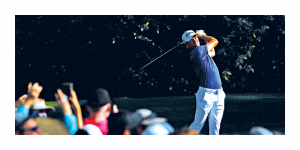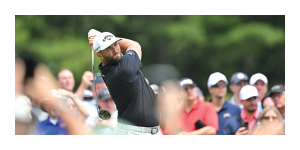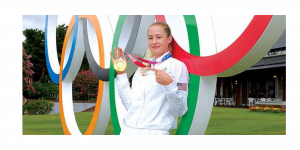How Well Do YOU Know The New Rules Of Golf?

1. In match play, a player moves a leaf lying close to his ball in a penalty area and in doing so causes his ball to move. What’s the ruling?
A) There is no penalty and the player must replace the ball.
B) The player gets one penalty stroke and must replace the ball.
C) The player loses the hole.
Correct answer: B
Explanation: If the removal of a loose impediment causes the ball to move, the ball must be replaced on its original spot. As the moved ball was not on the putting green or in the teeing area, he gets one penalty stroke (Rule 15.1).
2. In stroke play, player A looks into player B’s bag without touching or moving anything to see which club B used for his last stroke. What is the ruling?
A) There is no penalty.
B) A is disqualified.
C) A gets a penalty of two strokes.
Correct answer: A
Explanation: Information obtained by observation is not advice.
3. In stroke play, a player bends long grass near her ball so they can see the ball when playing their stroke. What is the ruling?
A) No penalty.
B) Two-stroke penalty.
C) One-stroke penalty.
Correct answer: B
Explanation: A player is not necessarily entitled to see their ball when making a stroke. By bending and moving the grass the player improved the lie of the ball and the area of intended swing contrary to Rule 8.1a.
4. In stroke play, a player’s ball comes to rest on a gravel surfaced road. They are entitled to relief from the road but decide to play the ball as it lies. They remove some gravel that might interfere with his stroke. What is the ruling?
A) No penalty.
B) One stroke penalty.
C) Two-stroke penalty
Correct answer: A
Explanation: Gravel is a loose impediment and a player may remove loose impediments without penalty anywhere on the course under Rule 15.1.

5. A player who damages his putter in anger after the first hole may continue to use the putter without penalty for the rest of the round.
A) False.
B) True.
Correct answer: B
Explanation: If a conforming club is damaged during the round, a player may continue to make strokes with the damaged club for the rest of the round (Rule 4.1a).

6. A player makes a practice swing and accidentally moves their ball in play on the fairway with their club. What is the ruling?
A) The player gets a one-stroke penalty and must replace the ball.
B) There is no penalty, but the movement of the ball counts as a stroke and the ball must be played as it lies.
C) There is no penalty, but the player must replace the ball.
Correct answer: A
Explanation: If a player causes their ball in the general area to move without making a stroke, there is a one-stroke penalty (Rule 9.4b).
7. A player may place a club on the ground during the stroke to aid in alignment.
A) False. B) True.
Correct answer: A
Explanation: A player must not take a stance for the stroke using any object, such as a club, that was set down by or for the player to help in lining up his or her feet or body (Rule 10.2b).
8. A player’s ball lies just off the putting green. Sand lies on the putting green between the ball and the hole. What is the ruling?
A) The player must not remove the sand.
B) The player may only remove the sand by picking it up or brushing it aside with their hand or a club.
C) The sand may be removed by any means.
Correct answer: C
Explanation: Sand and loose soil on the putting green may be removed without penalty (Rule 13.1c).
9. In match play, a player mistakenly believing they have won a hole, picks up their ball marker. What is the ruling?
A) The player loses the hole.
B) There is no penalty and the player must replace the ball or ball marker.
C) The player gets one penalty stroke and must replace the ball or ball marker.
Correct answer: C
Explanation: The player gets one penalty stroke (Rule 9.7b) and must replace his ball on its original spot (which if not known must be estimated).
10. In a stroke-play competition, the Committee issues the scorecards containing a player’s handicap in addition to their name and the date. The Committee mistakenly records the player’s handicap as seven instead of six and this affects the number of strokes received. The error remains unnoticed until after the card is returned, but before the competition has closed. What is the ruling?
A) The player’s correct handicap should be applied to his score.
B) The player is disqualified.
C) As it was a mistake of the Committee, the player should not be disqualified, however, the player’s handicap should be considered to be seven for the basis of the competition.
Correct answer: B
Explanation: If the Committee provides players with scorecards containing their handicaps, each player must make sure that the right handicap is shown on his or her scorecard before returning it. If such a scorecard mistakenly has a player’s handicap being higher than it actually is, and this affects the number of strokes he or she gets, the player is disqualified under Rule 3.3b if this mistake is not corrected before returning the scorecard.

11. When dropping a ball under a Rule, a player drops the ball from knee height twice and both times the ball comes to rest just outside the relief area, no nearer the hole. What is the ruling?
A) The player must place a ball on the spot where the ball first touched the ground from the second drop.
B) The player must continue dropping until a ball comes to rest in the relief area.
C) The player must place a ball anywhere in the relief area.
Correct answer: A
Explanation: If a ball has been dropped in the right way twice and both times comes to rest outside the relief area, the player must complete taking relief by placing a ball on the spot where the ball first touched the ground from the second drop (Rule 14.3c).
12. A player makes a stroke on the putting green with the flagstick in the hole. Their ball comes to rest against the flagstick with part of the ball below the surface of the putting green. The ball is considered holed.
A) False. B) True.
Correct answer: B
Explanation: If a ball comes to rest against the flagstick left in the hole, and any part of the ball is in the hole below the surface of the putting green, the ball is treated as holed.

13. In match play, a player’s ball lies in a penalty area and they take a practice swing in the penalty area, grounding their club in the process. What is the ruling?
A) There is no penalty.
B) The player loses the hole.
C) The player gets a one-stroke penalty.
Correct answer: A
Explanation: A player may ground his or her club anywhere in a penalty area without penalty (Rule 17.1b).
14. A ball is out of bounds when any part of it lies out of bounds.
A) False. B) True.
Correct answer: A
Explanation: A ball at rest is out of bounds only when all of it is outside the boundary edge of the course. A player may stand out of bounds to play a ball on the course.

15. In stroke play, when playing out of a bad lie, a player accidentally hits the ball a second time on their follow through. What is the ruling?
A) The double hit counts as one stroke only and there is no penalty.
B) The double hit counts as two shots but there is no additional penalty.
C) The double hit counts as one shot and the player gets an additional one stroke penalty.
Correct answer: A
Explanation: As per Rule 10.1a, an accidental double hit counts as one stroke. There is no penalty and the ball must be played as it lies.

16. A player finds their ball by stepping on it in thick rough after searching for it for two minutes, causing it to move. What is the ruling?
A) There is no penalty and the player must drop the ball as near as possible to the estimated spot.
B) There is no penalty and the player must place the ball on the estimated spot.
C) The player gets a one-stroke penalty and must place the ball on the estimated spot.
Correct answer: B
Explanation: There is no penalty if a player causes their ball to move while trying to find or identify it. If the ball is moved during the search, the ball must be replaced on its original spot (which if not known must be estimated). If the ball was under growing grass it must be replaced under that grass (Rule 7.4).

17. A player is entitled to free relief when his ball is embedded in the rough.
A) True. B) False.
Correct answer: A
Explanation: Relief is available for a ball that is embedded in the general area (except when it is embedded in sand in the general area).
18. A player plays their second shot, searches for the ball briefly and then announces they will go back and play a provisional ball. They drop and play a second ball from where the previous stroke was taken. The player then continues searching for their original ball and finds it within three minutes of when they first started searching for it. What is the ruling?
A) The player may choose whether to continue with the original ball or the provisional ball.
B) The player must continue with the provisional ball.
C) The player must continue with the original ball.
Correct answer: C
Explanation: As the original ball was found within three minutes, the player must continue with the original ball (Rule 18.3c).
19. A player’s ball is found by another player two minutes and 50 seconds after they began searching for it. It takes the player another 30 seconds to get to the ball and identify it as theirs. As the ball was identified after the three-minute search time had finished, the ball is considered lost.
A) True. B) False.
Correct answer: B
Explanation: If a ball is found within three minutes of the player starting to search for it, they are allowed a reasonable time to identify the ball, even if that happens after the three-minute search has ended.
20. In match play, a player, whose ball lies in a bunker, casually leans on his club in the bunker while waiting for his opponent to play. What is the ruling?
A) The player loses the hole.
B) There is no penalty.
C) The player gets one penalty stroke.
Correct answer: B
Explanation: There is no penalty for a player casually leaning on their club in a bunker, provided it is not for the purpose of testing the condition of the sand, or as otherwise prohibited by Rule 12.2b.
How did you do?
0-4 Have you picked up your copy of the Player’s Edition of the Rules of Golf? It might be worth reading it some time. We’ll make sure your club’s Committee keeps an eye on you.
5-8 You might want to hit the books, rather than the range. And download the R&A app while you’re at it.
9-12 Keep that copy of the Player’s Edition of the Rules of Golf handy in your golf bag, and the new rules could just help more than hurt your score.
13-17 Someone’s done their homework. The next time out, your foursome could consult you with some level of confidence.
18-20 Sleeping with the Official Guide to the Rules of Golf under your pillow has clearly paid off. A job as a rules official awaits.
More posts

The Championship Golf Of Evian and Mont Blanc
20 Aug 2023
HIT THE DRILL HOOK LIKE JUSTIN THOMAS
15 Aug 2023
FedExCup Playoffs 2023
10 Aug 2023
